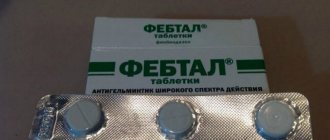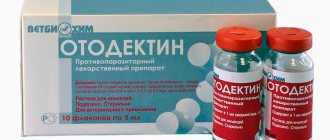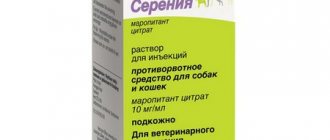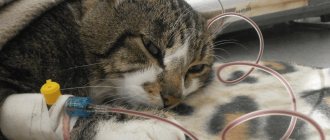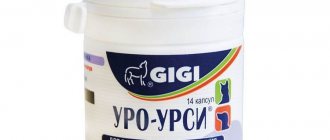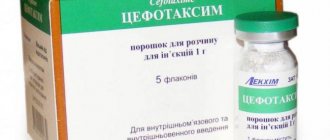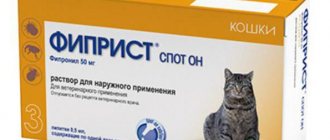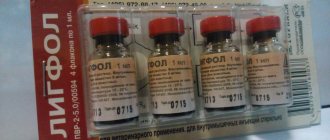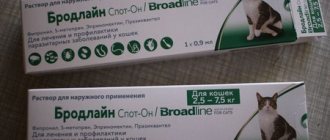Every loving owner takes responsibility for the health of his four-legged friend. But there are some diseases that are quite difficult to protect yourself from. These are diseases that are caused by parasites. Even cats and dogs that do not go outside are susceptible to infection with parasites: the infection can enter the house without this. How? We can bring it ourselves: on our own shoes or clothes in which we walk down the street. Therefore, you shouldn’t be too surprised when your shaggy pet suddenly starts scratching his ears. This can result in a tick infection. Severe itching in the ears, discharge, irritation on the face - all this can cause a lot of unpleasant moments for your pet.
In fact, diseases caused by parasites are highly treatable. Now there are many antiparasitic agents that successfully cope with this. One of these drugs is Amitrazine Plus.
pharmachologic effect
The product applied to the skin of the animal accumulates in the tissues and destroys mites, blocking their negative effects. Among the indisputable advantages of Amitrazine for cats, two of the most important should be highlighted: proven effectiveness regardless of the severity of the disease, as well as the ability to prevent its recurrence. This drug allows you to cure a cat from such ailments as: Otodecosis (ear scabies). The cat suffers from severe itching in the ear area. If proper measures are not taken in time, the result may be an inflammatory process, perforation of the eardrum, and hearing loss. Otitis (inflammation of the middle ear). The coordination of the animal’s movements is impaired, appetite deteriorates, and can lead to paralysis of the facial nerve. Notoedrosis (severe itching). Leads to fever, weight loss, baldness. The main component of the solution is amitraz. This substance effectively removes ticks Otodectes cynotis, Notoedres cati, Sarcoptes canis and S.vulpis. The pharmacological effect of the drug is as follows: it penetrates the skin of the animal, comes into contact with ticks, affects the receptors of parasites, which cannot move and ultimately die. The remaining components of Amitrazine play an equally important role: they facilitate the penetration of the active substance into places where mites accumulate, and also eliminate inflammation in these areas and promote rapid healing of wounds.
The use of Amitrazine in the treatment of demodicosis
Amitrazine is a drug that was previously used in veterinary medicine to combat various parasites, in particular ticks.
It is available in the form of ointment and drops, depending on the area to be applied to. Drops are more often used for animals, since their parasites are hidden deep in the shells of the ears.
But recently, Amitrazine ointment for people has become popular, which is most often used in the fight against demodicosis. It is applied according to the same principle as other similar products. The ointment has a wide spectrum of action - effective against gram-positive and gram-negative microorganisms, fungi
This is very important in the treatment of demodicosis, since due to the remains of the mite, the bacterial balance of the skin is disturbed, and pathogenic microorganisms begin to actively multiply
In addition, the ointment destroys sarcoptoid mites, causative agents of psoroptic mange, otodecosis, and demodicosis. Amitrazine has this pharmacological property due to the combination of two active ingredients: amitraz and decamethoxin. Their deep penetration into the skin is facilitated by the presence of dimexide in the ointment. But still, it is better to apply Amitrazine early in the morning and in the evening, when it is already dark. At this time, the bream is closer to the surface of the skin and is easier to destroy.
Amitrazine should be used as prescribed by a doctor, but it is advisable that the course of treatment be at least two months, because the fact that the symptoms have disappeared does not mean that the tick is completely defeated. You can stop treating the disease only after the laboratory does not find a mite on the eyelashes and scrapings of human skin.
It is important to note that those who have used Amitrazine say that in the first week or two the symptoms of the disease intensify: the eyes begin to itch even more, become red, swollen, and bumps may appear on the eyelids. But it goes away after a while
This happens because the affected tick tries to free itself from the influence of toxic substances on it and begins to actively move.
When using Amitrazine, you should avoid prolonged exposure to the sun, visiting a solarium, sauna - warm air and the sun create ideal conditions for tick reproduction. In addition, thanks to them, the parasite penetrates deeper and deeper into the skin tissue.
You need to apply the ointment to each eye with a separate finger, since the degree of infection of the right and left eyes can be different; careless attitude can lead to infection of one eyelid from the other. Amitrazine has virtually no side effects, except for individual intolerance to the components of the drug. Therefore, it can be used without much concern, but pregnant women should avoid treatment with this ointment, since no studies have been conducted on the effect of the drug on the development of the fetus.
The price of Amitrazine allows anyone to purchase it - 10 ml costs an average of 45 rubles, and this amount lasts for a long time.
Despite the fact that the ointment is relatively harmless and effective, you should definitely consult a doctor before applying Amitrazine to the skin of the face, and even more so to the eyes - this is a very sensitive organ that is easily influenced by negative factors.
Instructions for use
Before starting treatment, veterinarians strongly recommend studying the instructions for use of Amitrazine for cats. It clearly and clearly describes how and in what dosage the medication should be applied so as not to harm the pet’s health. The algorithm for its use is not complicated and consists of several stages: Using a cotton pad or swab, treat wounds on the skin, washing away dirt, plaque and scabs. This way the solution will completely penetrate the affected areas and begin to act faster. The medicine is carefully distributed over the entire wound in an even layer, it is also necessary to treat the healthy skin around it, retreating about 1 cm. If otodecosis is detected in a pet, then you should apply the medicine to the wounds in the ears, and also do not forget to introduce Amitrazine drops into both ears . If the cat has a severe form of the disease, in which there are extensive inflamed areas on the body, then the treatment will need to be divided into two stages: on the first day, treat one part of the body, on the second day, another. Make sure that your pet does not lick the medicine for 15-20 minutes after treating the wounds. You can put on a muzzle or make a gauze loop to secure the jaw closed. Composition Amitrazine is sold in pharmacies in bottles of 10, 15 or 20 milliliters. The solution has an oily consistency and a specific odor. Amitrazine contains three components, each of which has a specific purpose: amitraz (0.25%) has an intense acaricidal effect, destroying parasitic insects, rapeseed oil accelerates the healing process of wounds, and dimethyl sulfoxide (30%) disinfects them.
Dosage
How much solution is needed for complete and effective treatment is determined by the doctor in each specific case. The dosage depends on the severity of the disease, as well as the health of the cat. If the veterinarian advised you to use the recommendations from the instructions for Amitrazine for cats, then you will need to find out the body weight of your pet. The required volume of medicine is calculated according to the following scheme: from 0.2 ml to 0.5 ml of solution per kilogram of animal weight. The product in the required dose is applied to the affected areas 2-5 times a day for 5-7 days. If a cat suffers from otodecosis, then you need to instill 0.5 ml of medicine into each ear.
Amitrazine for cats is a budget drug. Its cost varies from 50 to 100 rubles. Price and quick results are the main advantages noted by both veterinarians and pet owners.
special instructions
The main thing before starting to use Amitrazine is to familiarize yourself in detail with all the possible consequences, precautions and reviews. For example, you should apply the medicine not only to the affected area, but also to the skin around it. This allows you to stop the infection and improve the cat’s condition faster.
The owner should also clearly study all the active components of the drug. If at least one item from the composition can cause an allergic reaction in the cat, you should stop using the product. By the way, if there are wounds or damage to your pet’s skin, when Amitrazine is applied, the animal may feel an unpleasant burning sensation. This should be taken into account as the reaction may be unexpected.
Contraindications and precautions
Despite the fact that the reviews about Amitrazine are quite good, like any drug it has several contraindications. It cannot be used if: the cat is pregnant or nursing kittens; there is an allergy to the medication; The kittens are less than two months old. So, if you are the owner of a small kitten or a pregnant cat, then you should find another way to treat the disease; Amitrazine will not suit you. It can harm your pet, causing much more harm than good. Veterinarians also draw attention to the need to take precautions: do not allow the cat to lick the solution from the treated skin, do not exceed the dose, and also keep in mind that Amitrazine can cause a burning sensation in the application area. In addition, the pet owner himself should be careful when treating wounds. If you are prone to allergies, it is best to avoid contact with Amitrazine and wear rubber gloves.
What does the product look like?
Veterinary medicine offers oily liniment for external use. The drops have a yellow tint and a specific smell. They can be purchased in 10 ml packaging, in plastic packaging with a convenient pipette. It is possible to purchase the drug in glass containers, volume 15 or 20 ml.
What does it contain?
Two versions have been developed - “Amitrazine” and “Amitrazine Plus”. Active components:
- Amitraz. An acaricide that destroys ticks in any phase of development.
- Dimethyl sulfoxide. Relieves inflammation and pain.
- Rapeseed oil. Facilitates penetration, stimulates regeneration.
- Decamethoxin - only in Amitrazine Plus. Antiseptic.
When is it prescribed?
Veterinarians use the drug when infecting domestic animals with various types of ticks and the resulting pathologies. Types of diseases are presented in the table:
| Disease | Pathogen | Symptoms | Possible complications |
| Otodectosis (especially dangerous for fold-eared breeds) | Ear mite | Ear inflammation, unpleasant-smelling black discharge, itching, sores | Purulent otitis media |
| Demodicosis | Skin mite | Itching, irritation, ulcers, hair loss | Diseases of internal organs |
| Notoedrosis | Scabies mite | Scabies, baldness, skin inflammation | Diseases of the cardiovascular and nervous system |
Pharmacological characteristics
This veterinary drug destroys ticks at any stage of development, and does not have a toxic effect on animals. Amitrazine for cats can accumulate in the upper layers of the skin, hair follicles, and glands - fat and sweat.
When applied to the affected areas, in addition to destroying parasites, the product relieves inflammation, has a bactericidal, antiseptic effect, and stimulates the regeneration process. In most cases, cats tolerate the drug without discomfort.
How to use
When to use amitrazine for cats, how much to drip the drug, how to treat the affected areas - this can only be determined by a qualified veterinarian. Self-medication, although the drug is harmless, can be dangerous for your pet.
Measures should be taken to prevent the cat from licking off chlorpromazine after application for 20-30 minutes. You can put a special plastic collar on the animal, temporarily tie up the jaw, or hold it in your arms after wrapping it in a towel.
The rules for taking Amitrazine Plus, the instructions for use of which for cats describe all the details, are similar to taking Amitrazine. The veterinarian gives precise recommendations on the choice and administration of the drug after examining the animal and establishing a diagnosis.
Treatment regimens
Approximate treatment regimens are in the table:
| Disease | How to use | Treatment regimen | Note |
| Otodectosis | Use a cotton swab to thoroughly clean your ears. Drop 0.5 ml into each ear. For better penetration of the medicine, bend and massage the auricle. If it is necessary to treat the skin with a swab soaked in the medicine, treat the affected skin and the area around it for about 10-20 mm. | The treatment is carried out once a day, repeated on the fourth day. Cycle – 5-7 procedures. | If only one ear is affected, treatment must be carried out for both |
| Demodicosis | The drug is applied with a swab to cleansed skin at the site of the lesion, as well as to the fur around 10-20 mm. | Once a day, repeat on the fourth day. Cycle – 6-8 procedures. | In severe cases, immunostimulating drugs are additionally administered |
| Notoedrosis | The skin is cleansed with an alcohol-containing product. The drug is applied to the affected area and the fur around it - 10-20 mm. | Once a week. Cycle – 2-5 procedures. | If the affected area is large, treatment is divided into two stages: half of the body on one day, the second on the other. |
Recommended Limits
When used correctly, amitrazine does not harm animals. The manufacturer does not recommend the drug if the cat is expecting offspring or nursing kittens, or for kittens under 2 months of age. A contraindication is an allergy to the components of the drug.
Possible discomfort
According to the instructions for Amitrazine for cats, only a slight burning sensation that appears when treating open wounds or severe scratching can be considered a side effect. It does not cause much discomfort to the pet and passes quickly.
How to store
Amitrazine is used within two years from the date of manufacture. Proper and safe storage conditions must be observed. It is necessary to provide:
- protection from sun rays;
- room temperature;
- out of reach of children and pets.
Advantages and disadvantages
Amitrazine for cats has its advantages and disadvantages. The advantages include:
- efficiency of application;
- quick results;
- simplicity and ease of use;
- convenient release form with a pipette spout;
- budget cost.
The disadvantages include the need to protect the treatment site from licking by animals for 20 minutes. We also must not forget about the possibility of individual intolerance to the components of amitrazine, which causes an allergic reaction.
Owners' opinion
Cat owners are generally satisfied with the results of the treatment. Here are some reviews:
- “After a weekend at the dacha, the cat started shaking his head and scratching his ears until they bled. The veterinarian prescribed Amitrazine. After a few days of instillation, the problem disappeared”;
- “We noticed that the cat was itching, hair was falling out, and wounds appeared. The clinic discovered a tick infestation. The scratches were treated with Amitrazine. It is difficult to stop the cat from licking it, and the smell is unpleasant. But she recovered completely."
Veterinarians' opinion
Professionals warn of the possibility of an individual reaction: lethargy and nausea. Among the advantages of amitrazine, veterinarians note:
- efficiency at budget cost;
- wide spectrum of action;
- destruction of all generations of parasites;
- rapid appearance of results.
Based on the opinion of veterinarians and cat owners who have already used the drug, we can draw a conclusion about the effectiveness of Amitrazine and Amitrazine Plus. Instructions for use for cats describe in detail treatment regimens, dosages and possible limitations of the drug.
How to use Amitrazine
Schemes for using Amitrazine to combat ear and subcutaneous mites differ.
Treatment procedure for otodectosis
For otodectosis, treatment with Amitrazine is carried out as follows:
- After moistening the swab with the preparation, thoroughly clean the inner surface of the ear from all contaminants.
Not all veterinarians recommend cleaning the ear with a mite killer, as it is still somewhat toxic. For this purpose, you can use milder preparations, for example, lotions with an anti-inflammatory effect: Bars, Cliny and others. You can clean your pet’s ear before treating with Amitrazine using any ear lotion intended for cats. - After this, 0.5 ml (about 10 drops) of Amitrazine is instilled into the ear canal (this volume of the drug is indicated in the instructions for use, but it is still better to check the dose with a doctor). You can more accurately determine the volume using an insulin syringe. Then the auricle is bent and lightly massaged at the base. Massaging ensures the penetration of the medicine into all internal cavities of the ear.
- This procedure is repeated for the second ear. Treatment is mandatory for both ears, even if there are no signs of disease in one of them.
- A week later, the treatment is repeated.
According to the instructions for use of Amitrazine, two treatments are sufficient, since the full development cycle of a tick is about 9 days, and within a week, all the eggs will hatch into larvae that will die after the second treatment. But this is ideal. The auditory concha has a complex shape, and if at least one mite remains somewhere in the folds, after a while the disease will resume. Therefore, it is still better to carry out several treatments to ensure that all parasites are destroyed.
If the drug gets on an open wound, it causes severe pain, so if the skin and inner cavity of the ear are injured, it must be applied with caution. If tick infection has already led to the development of otitis, additional treatment is carried out to relieve the inflammatory process, which is prescribed only by a veterinarian
If tick infection has already led to the development of otitis, additional treatment is carried out to relieve the inflammatory process, which is prescribed only by a veterinarian.
Video: how to clean a cat's ears
Scheme for using Amitrazine against subcutaneous mites
Treatment procedure for Amitrazine against subcutaneous mites:
- It is advisable to cut the hair in the affected areas to make it more convenient to apply the drug, while keeping in mind that 10 mm of healthy skin is captured in the border zone.
- Clean off any scabs and crusts from the affected areas. To soften scabs, you can use warm water with the addition of tea tree oil extract, calendula, kelp or other substances with keratolytic and disinfectant properties.
- Apply Amitrazine with a swab to the affected areas, starting from the border zones, moving towards the center. The dosage is calculated according to the formula 0.2–0.5 ml (depending on the degree of development of the disease) per 1 kg of cat weight.
- Animals should not be allowed to lick the drug for 15–20 minutes.
To do this, you can use a veterinary cone or simply wrap the cat in a towel and hold it in your arms. For 20 minutes after treating the skin with Amitrazine, you can put an Elizabethan collar on the cat.
This procedure is carried out two to five times, depending on the development of the disease, every 5–7 days. In case of severe damage, each treatment is carried out in two stages: first, one half of the body, the next day - the second
This precaution is necessary to prevent an overdose of the drug. When fighting microscopic mites, a repeated treatment procedure is required, since the drug affects only the larvae and adults of the parasite; it does not destroy mite eggs
The animal’s recovery is determined based on the results of the veterinary clinic’s analysis.
Amitrazine for cats: instructions for use, reviews
Amitrazine is a drug intended to remove ticks from cats. Veterinarians prescribe this medicine to rid the animal of diseases associated with the appearance of ticks. Despite its high effectiveness, Amitrazine for cats has contraindications and can also cause unwanted side effects. In this regard, before starting use, it is recommended to read the instructions.
Pharmacological properties and composition
After application to the skin of the animal, the drug begins to gradually accumulate in the body. After reaching the required concentration, the active ingredients begin their effect, during which the mites are destroyed.
The drug is intended for the treatment of the following diseases:
- Otodecosis or ear scabies. The main symptom of the disease is severe itching in the ears. If timely treatment is not started, the disease will lead to a severe inflammatory process that can affect the eardrum, causing the cat to lose hearing.
- Inflammation of the middle ear or otitis media. This is also a dangerous disease that can cause paralysis of the facial nerve. Symptoms of the disease are impaired coordination of movements and poor appetite.
- Notoedrosis is a disease characterized by severe itching. In the absence of proper treatment, it leads to a number of negative consequences: baldness, weight loss, fever.
The active ingredient of the drug is amitraz. The principle of its action is as follows: the medicine penetrates the animal’s skin and hits the ticks, paralyzing them. In addition, it promotes wound healing and relieves inflammation.
Additional components included in the composition include:
- rapeseed oil - intended for speedy wound healing;
- dimethyl sulfoxide - for disinfection;
- purified water.
The drug is sold in veterinary pharmacies and specialized stores. Sold in bottles of 10, 15 and 20 ml.
Release form and effect of the drug
Amitrazine is available in the form of a solution used for external use and is an oily liquid. The solution is packaged in plastic bottles with an elongated dropper spout or glass bottles of 10 ml. Contains 0.25% amitraz - the active ingredient and auxiliary substances dimethyl sulfoxide and rapeseed oil.
Amitraz, as part of a veterinary drug, is an acaricide of systemic and contact action; it actively affects sarcoptic mites parasitizing cats both in the larval phase and in the phase of sexually mature individuals. This is a non-toxic drug, relieves inflammation, kills bacteria and softens the skin in affected areas. The accumulation of the drug occurs in the hair follicles, epidermis, and fatty glands. Animals tolerate this drug well.
Directions for use and dosage
You should definitely read the instructions for use of Amitrazine for cats before using the medicine.
The algorithm for its application consists of several stages:
- Pre-treatment of the leather surface. This can be done using a cotton pad soaked in an alcohol solution.
- After the skin is prepared, lubricate the affected areas with the product, covering healthy areas by about 1 cm.
- For otodecosis, it is recommended to apply the drug to wounds in the ears. Regardless of which side is affected, both ears must be treated.
If diseases associated with the appearance of ticks are severe, then treatment of the affected areas must be done gradually: on one day - only one part of the body, and on the second day - the remaining areas.
It is important to ensure that the pet does not lick itself during the next 10-15 minutes after treatment, otherwise the medicine will enter the body and may cause poisoning, but will not have the desired effect. For this purpose, you should prepare a muzzle or gauze loop in advance, which will ensure the closure of the jaw.
In order to determine the required dose, you need to know the weight of the animal. So, for every kilogram of body weight you will need from 0.2 to 0.5 ml of solution. The drug must be applied to the affected areas of the body 3-5 times a day. The course of treatment should be at least 7 days.
The exact dosage is determined by the attending veterinarian. It depends on the severity of the disease, as well as its type. No cases of drug overdose have been identified, but caution must still be exercised.
Contraindications and side effects
Despite its high effectiveness, the drug has contraindications.
Thus, treatment is not recommended to begin in the following cases:
- During lactation and pregnancy of a cat. In this case, it is recommended to additionally consult with a specialist.
- If the animal has an individual intolerance to the components that make up the medicine.
- When the animal is less than 8 weeks old.
The medicine can cause a number of side effects. The most common ones are :
- an allergic reaction manifested by skin rashes, redness, itching and swelling;
- aggressive behavior of the animal;
- general weakness.
In case of side effects, it is necessary to immediately remove the drug from the animal’s skin. To do this, you need to moisten a cotton pad or small cloth in water and wipe the treated areas. If necessary, it is recommended to consult a veterinarian.
If a person has a tendency to experience allergic reactions, then it is better not to inhale the drug, and also use rubber gloves during application.
The animal should not lick the solution, but if this does happen, the animal’s health should be monitored. Your cat may experience unpleasant symptoms :
- attacks of nausea and vomiting;
- aggressive behavior - it appears due to a feeling of unpleasant taste in the mouth;
- general weakness;
- refusal to eat.
In this case, it is necessary to provide the animal with plenty of fluids and show it to a specialist.
Side effects
If you use the medicine in strict accordance with the rules described above, then side effects are extremely unlikely. But with an increase in the frequency of treatments, overdoses and/or unreasonably long-term use, the following is possible:
- Redness and irritation on the surface of the skin is likely.
- In more severe cases, rather deep cracks, diaper rash, and “scales” appear on the surface of the skin.
- If the medicine is applied completely uncontrollably and in extremely large quantities, it can lead to dermatitis, eczema and even ulcers (but this still happens extremely rarely).
Price and storage conditions
The drug must be stored in a place inaccessible to children. It is better to keep it in its original packaging, at an air temperature of 0 to 25 °C. Avoid exposure to direct sunlight.
The shelf life is 24 months. It is not recommended to use the medicine after the expiration date, as this may be harmful to health.
The cost of the product varies from 50 to 100 rubles . The price directly depends on the volume of the bottle, as well as on the region where the drug is sold.
Reviews about the use of the drug
There are many reviews left by cat owners on thematic forums on the Internet. They treated their pets with this particular drug.
I learned about Amitrazine several years ago when I was treating a cat for ticks. Since then, the medicine has always been in our veterinary medicine cabinet, and once a quarter we treated the cat’s ears as a preventive measure.
And recently a cat got into a fight with another cat on the street, and mine was left with scratches. I first treated them with hydrogen peroxide, and then with this drug. The wounds healed very quickly, despite the fact that the animal felt discomfort during treatment (probably pinched the wounds). But they recovered. The price of the drug is within 50 rubles.
A few months ago, our beloved cat was diagnosed with otodecosis, in other words, ear mites. The vet prescribed this medicine. The drops were bought at a veterinary pharmacy for 68 rubles. Started using it on the first day. The product has many advantages: it moisturizes the ears well, is easy to apply, disinfects existing wounds and promotes rapid healing.
We did not find any disadvantages, since the cat recovered within a few days. I recommend the drug to all dog and cat owners for preventive use.
I have been using Amitrazine for a long time to treat animals (I have a dog and two cats). I often use it as a preventive measure against ear mites. Despite the fact that all three live at home, they still periodically catch this disease. Perhaps they pick on us when we go out for a walk.
But recently I had two street kittens living in my foster home. This is where the medicine really came in handy. In 5 days I managed to rid my kittens of otodecosis using this medicine. Since the kittens were still small (3 months old), I treated their ears with it 3 times a day - in the morning, at lunch and in the evening. The course of treatment was fruitful. The medicine is effective and inexpensive.
Analogues of the drug Amitrazine
- Amit Forte - prescribed for demodicosis, notoedrosis, sarcoptic mange, otodectosis, cheyletiosis. The main components in this medicine are fipronil, diphenhydramine (has a mild sedative effect).
- Decta Forte is used to treat animals affected by skin and ear mites. Ingredients: fipronil, chloramphenicol, lidocaine hydrochloride (anesthetic). Animals tolerate it more easily, since the drug has an analgesic effect.
- Aversectin ointment 0.05% is prescribed for the treatment of sarcoptic mange, demodicosis, otodectosis, entomosis, and notohedrosis in dogs and cats. The ointment is practically odorless and is well tolerated by pets.
Description of the drug
The drops are an oily liquid intended for the treatment of diseases such as demodicosis, notoedrosis, and otodectosis in domestic animals. All these ailments are caused by the proliferation of various mites in the ears and on the skin of cats and dogs.
Demodicosis is an infection of the skin of an animal by the demodex mite, manifested by severe itching, baldness, and the formation of abscesses, which often burst and cause irritation.
Notoedrosis is a disease of cats caused by the itch mite, leading to inflammation of the skin, scabies, hair loss, and disrupting the functioning of the nervous and cardiovascular systems.
Otodectosis is a lesion of the external auditory canal in pets, especially fold-eared breeds. It manifests itself as itching, inflammation in the ear, the appearance of sores and black, foul-smelling masses.
“Amitrazine,” the instructions for use of which are intended for cats and dogs, effectively copes with these diseases. However, before using it, you should consult a veterinarian to avoid unwanted side effects.
When is it appointed?
The effectiveness of a drug based on amitraz was proven by Candidate of Biological Sciences Mikheev S.V. in his dissertation on the topic “Amitrazine in the treatment of tick-borne infections in domestic animals,” which describes in detail what types of parasites the drug affects. And that the scientist, that the official instructions recommend the use of Amitrazin drops for such pathological conditions as:
The product is relevant for the treatment of diseases caused by microorganisms.
- Demodecosis. Parasitic infection of a pet's skin by demodex mites, accompanied by severe itching, pustules, and baldness.
- Ear scabies. Acariasis caused by parasitic ear mites Otodectos cynotis. In cats, the ears begin to itch and become inflamed, and black masses appear with a specific odor.
- Notoedrosis. A parasitic disease of cats, the appearance of which is caused by scabies mites of the genus Notoedris cati. With this disease, purrs experience hair loss, disruption of the nervous system and cardiovascular system, itching and inflammation of areas of the dermis.
Composition of the medicinal product
Drops have two forms of release, differing in their composition. A product called “Amitrazine” consists of the following components:
- amitraz is the main substance whose action is aimed at combating various types of mites that parasitize the skin or ears of an animal;
- dimethyl sulfoxide – an auxiliary component that has an anti-inflammatory and analgesic effect;
- rapeseed oil – promotes better penetration of the medicine and has healing properties.
“Amitrazine Plus” has a slightly improved composition that allows you to achieve the desired result even faster. In addition to the above components, this drug contains a substance called decamethoxin, which has antiseptic properties. The combined action of amitraz and decamethoxin not only effectively copes with the disease, but also prevents its reappearance.
“Amitrazine”: instructions for use
The drops in question are suitable for treating cats and dogs, so it is important to carefully study the instructions, because the dosage for these animals will be different.
- Before use, it is better to bandage the pet’s jaw or put on a muzzle so that the animal cannot lick the drug prematurely.
- During otodectosis, the ears are cleaned of dirt and crusts that have formed, the shell is folded in half, gently massaged at the base for better penetration of the medicine, then the required amount of the product is dripped.
- For skin lesions, the drug is applied to the affected area and to the areas around the lesion by 1-2 cm.
- The dosage is calculated based on the animal’s body weight and is 0.5 ml per kg of weight.
- Treatment is carried out once a day every three days until the disease completely disappears. Usually the course is from 5 to 7 treatments.
- You can free your pet's jaw 20 minutes after using the drops, during which time they are well absorbed.
“Amitrazine Plus” has similar instructions for use, consisting of the following recommendations:
- for the treatment of ear diseases, instill 2-3 drops into each passage;
- for skin ailments, apply a centimeter to the affected areas and the area around them;
- the medicine is used once a day;
- the course is 6-8 treatments.
When used correctly, the drug has no side effects; contraindications include personal intolerance to the main substances, pregnancy and the age of the animal up to two months.
Indications for use
The instructions for the drug Amitrazine Plus inform that this drug will be effective in the treatment of diseases:
- Demodicosis is an infection of an animal by mites living in the hair follicles. Only young dogs and cats or older animals are more susceptible to this disease. Infection of an adult healthy animal with this type of tick is almost impossible. The disease has the following signs: itching appears (the animal is constantly itching), then redness at the base of the hair becomes noticeable. After a few days, bubbles form at the site of the redness, which then burst. Often, scales can be found on the animal’s body, near which the fur looks stuck together. Over time, the scales fall off along with the fur. Pus will be visible in this area.
- Otodectosis - in this disease, the pathogen parasitizes in the animal’s auricle or in the external auditory canal. An animal infected with this mite suffers from severe itching in the ears: the pet begins to shake its head, constantly itch, and rub its ears on any hard surface in an attempt to relieve the itching. Due to mechanical irritation by animals of their ears, a secondary infection or even purulent otitis may occur. A characteristic sign of an animal being infected with otodectosis is the appearance of dark brown (almost black) discharge from the ear canals.
- Notoedrosis - cats are more susceptible to this disease. This is a chronic disease that is characterized by inflammation of the skin on the animal’s head, hair loss at the site of the lesion, severe itching and scratching. Young cats are more susceptible to infection. The first signs of the disease can be seen on the eyebrows, the bridge of the nose, and at the base of the ears. The infection can then spread to other areas of the cat's body: chest, paws, lower abdomen.
- Psoroptosis (cutaneous scabies) - characterized by itching in the affected areas, the skin in these areas becomes folded, thickened, hot (local increase in temperature). Nodules form on the skin, which then become blisters. Over time, the bubbles burst and crusts remain in their place. The hair on the affected areas falls out.
- Sarcoptic mange is a disease caused by itch mites. Most often, the muzzle, forehead, wings of the nose are susceptible to infection, and then the entire body of the animal is covered. Infected areas are very itchy, which causes great discomfort to the animal. Affected cats can be “identified” by their appearance: the animal becomes covered with scabs, crusts, and bald patches appear.
- Otitis and dermatosis caused by ear mites.
“Amitrazine”: reviews
Pet breeders are generally satisfied with the use of these drops and note the following positive aspects:
- High efficiency, the first improvements become noticeable the very next day.
- Simplicity and ease of use.
- Economical packaging.
- Low cost of the drug “Amitrazine”. Its average price is 70 rubles.
Among the negative qualities, animal breeders note the unpleasant odor of droplets, nausea, and lethargy of the pet in case of individual intolerance to the medicine.
Thus, for the treatment of ear and skin diseases of cats and dogs caused by various mites, it is recommended to use the drug “Amitrazine”, instructions for use of which are in each package. The medicine is characterized by effectiveness and affordable price.
